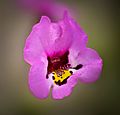Purplelip pansy monkeyflower facts for kids
Quick facts for kids Purplelip pansy monkeyflower |
|
|---|---|
| Scientific classification | |
| Genus: |
Diplacus
|
| Species: |
angustatus
|
Diplacus angustatus is a special kind of monkeyflower. People also call it the purplelip pansy monkeyflower or the narrowleaf pansy monkeyflower. It's a small, pretty wildflower with pink or purple flowers.
Contents
Where This Flower Lives
This monkeyflower is special because it only grows in California. When a plant or animal only lives in one place, it is called endemic. You can find it scattered across different parts of California. It grows in the North Coast Ranges, the San Joaquin Valley, and the Sierra Nevada foothills.
This little plant likes wet, open places. It often grows near vernal pools, which are temporary ponds that fill with water in the spring. It also likes meadows. Sometimes, its tiny pink flowers can cover a whole area like a soft carpet!
What This Flower Looks Like
Diplacus angustatus is a very small plant. It's an annual herb, which means it lives for only one year. It grows in small clumps close to the ground. Its stems are super thin, often less than a centimeter (about half an inch) tall.
The plant can be green or reddish. Its leaves grow in pairs and are long and narrow, about 1 to 3 centimeters (less than an inch and a half) long.
The flower has a tube-like base. This base is surrounded by a hairy, green or red cup called a calyx. The flower itself is called the corolla. It can be light pink, bright pink, or even reddish-purple. You might see one or more big purple spots inside the flower's throat. Sometimes, it also has yellow markings. The flower looks like a trumpet and can be several centimeters long. That's much longer than the tiny stem it grows on!
How Animals Help It Grow
Scientists have studied this wildflower. They found that the plant grows better when the soil around it is disturbed. This is especially true when pocket gophers are active. Pocket gophers are small rodents that dig tunnels.
When gophers dig, they mix up the soil. Plants that grow in this disturbed soil have bigger flowers. They also have fewer other plants competing for space and nutrients. Plus, these flowers get more pollen on their stigmas. This means more pollen from other D. angustatus plants reaches them, which helps them make more seeds. So, gophers actually help these pretty flowers thrive!
Images for kids
-
Diplacus angustatus growing in Napa County, CA.


